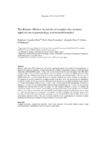Mostrar o rexistro simple do ítem
The Rücker–Markov invariants of complex bio-systems: applications in parasitology and neuroinformatics
| dc.contributor.author | González-Díaz, Humberto | |
| dc.contributor.author | Riera-Fernández, Pablo | |
| dc.contributor.author | Pazos, A. | |
| dc.contributor.author | Munteanu, Cristian-Robert | |
| dc.date.accessioned | 2017-11-09T11:20:13Z | |
| dc.date.available | 2017-11-09T11:20:13Z | |
| dc.date.issued | 2013-02-23 | |
| dc.identifier.citation | González-Díaz H, Riera-Fernández P, Pazos A, Munteanu CR. The Rücker–Markov invariants of complex bio-systems: applications in parasitology and neuroinformatics. Biosystems. 2013;111(3):199-207 | es_ES |
| dc.identifier.issn | 0303-2647 | |
| dc.identifier.issn | 1872-8324 | |
| dc.identifier.uri | http://hdl.handle.net/2183/19716 | |
| dc.description.abstract | [Abstract] Rücker's walk count (WC) indices are well-known topological indices (TIs) used in Chemoinformatics to quantify the molecular structure of drugs represented by a graph in Quantitative structure–activity/property relationship (QSAR/QSPR) studies. In this work, we introduce for the first time the higher-order (kth order) analogues (WCk) of these indices using Markov chains. In addition, we report new QSPR models for large complex networks of different Bio-Systems useful in Parasitology and Neuroinformatics. The new type of QSPR models can be used for model checking to calculate numerical scores S(Lij) for links Lij (checking or re-evaluation of network connectivity) in large networks of all these fields. The method may be summarized as follows: (i) first, the WCk(j) values are calculated for all jth nodes in a complex network already created; (ii) A linear discriminant analysis (LDA) is used to seek a linear equation that discriminates connected or linked (Lij = 1) pairs of nodes experimentally confirmed from non-linked ones (Lij = 0); (iii) The new model is validated with external series of pairs of nodes; (iv) The equation obtained is used to re-evaluate the connectivity quality of the network, connecting/disconnecting nodes based on the quality scores calculated with the new connectivity function. The linear QSPR models obtained yielded the following results in terms of overall test accuracy for re-construction of complex networks of different Bio-Systems: parasite–host networks (93.14%), NW Spain fasciolosis spreading networks (71.42/70.18%) and CoCoMac Brain Cortex co-activation network (86.40%). Thus, this work can contribute to the computational re-evaluation or model checking of connectivity (collation) in complex systems of any science field. | es_ES |
| dc.description.sponsorship | Programa Iberoamericano de Ciencia y Tecnología para el Desarrollo; Ibero-NBIC, 209RT-0366 | es_ES |
| dc.description.sponsorship | Ministerio de Ciencia e Innovación; TIN2009-07707 | es_ES |
| dc.language.iso | eng | es_ES |
| dc.publisher | Elsevier | es_ES |
| dc.relation.uri | http://dx.doi.org/10.1016/j.biosystems.2013.02.006 | es_ES |
| dc.rights | Atribución-NoComercial-SinDerivadas 3.0 España | es_ES |
| dc.rights.uri | http://creativecommons.org/licenses/by-nc-nd/3.0/es/ | * |
| dc.subject | Complez networks | es_ES |
| dc.subject | Parasite–host networks | es_ES |
| dc.subject | Brain cortex network | es_ES |
| dc.subject | Walk count | es_ES |
| dc.subject | Markov chains | es_ES |
| dc.subject | Graph topological indices | es_ES |
| dc.subject | Quantitative structure–property relationship | es_ES |
| dc.title | The Rücker–Markov invariants of complex bio-systems: applications in parasitology and neuroinformatics | es_ES |
| dc.type | info:eu-repo/semantics/article | es_ES |
| dc.rights.access | info:eu-repo/semantics/openAccess | es_ES |
| UDC.journalTitle | Biosystems | es_ES |
| UDC.volume | 111 | es_ES |
| UDC.issue | 3 | es_ES |
| UDC.startPage | 199 | es_ES |
| UDC.endPage | 207 | es_ES |
Ficheiros no ítem
Este ítem aparece na(s) seguinte(s) colección(s)
-
GI-RNASA - Artigos [195]






